It would be ideal to just pull from a list of B2B customers and know how they get value out of your product. While that database doesn’t exist, value is a huge component in any product’s monetization strategy. How can B2B companies not run in circles figuring this out? Software Pricing Partners Managing Partner Chris Mele shares insights into value and how a pricing strategy is important to product development.
Subscribe to the Product Talk podcast on Spotify and Apple Podcasts, and make sure you never miss a single product conversation with leading product executives. New episodes live every Wednesday.

On Pricing Strategy Factors
Host Nikki Ahmadi started the conversation with Chris about how companies can formulate their pricing strategies. We learn that the way forward isn’t always clear. Product managers craft the strategy. You need to create frameworks, and you need to implement them correctly.
“You are trying to craft a strategy to attract a very particular, or well-defined group of customers that we’ll call your ideal customers, and we’ll call that your go-to-market strategy. Often, the go-to-market strategy is formulated in the traditional marketing stack, and eventually, we drive down to a list of names that we want to target.”
“That’s kind of what happened to us. In my software company, we were chasing our tails around and around. After six months, I just said, this is madness. I reached out for help because we just couldn’t figure it out. It’s actually not that complicated. But if you don’t have frameworks, and things to figure it out, It feels like it’s almost impossible.”
On Value-Based Pricing
Chris pointed out is there are two definitions: one sounds like used car sales while the other is much harder to truly pull off with product sales. Product managers must be able to justify value. They need to know why they price their products the way they do. They also must be prepared to face challenges along the way.
“Value-based pricing is largely misunderstood. It’s not about getting the most out of every transaction. This leads us down a bit of an ethical quandary in the opposite of the world today that demands transparency on the buying front.”
“Value-based pricing rapidly becomes a conversation of, well, if I’m selling this product in version A, and then I’m going to switch from manufacturing to pharmaceuticals — which pharmaceuticals make a killing right now — they have a bigger willingness to pay; I should charge them more. That’s not value-based pricing. It’s used car sales.”
“You will face a lot of challenges and problems along that road. Trust is the big one. most specifically is just the aspect of trust. You can’t really say that we put the customer at the center of our universe and be okay that Nikki got a 60% discount and Chris got a 90% discount for the exact same thing. You have to treat the customer fairly.”
On How To Keep Pricing Simple
As product offerings get more complicated, the pricing strategies might follow suit. It comes down to keeping pricing simple, easy to understand, and effective to drive sales and customer value.
“It is the antithesis of an ever more complicated product. As the product matures, we bring in third-party components that have different costs. So, this other component over here might be transaction-based. Still, this other one might be on some other basis. We have more complications and broader configurations. We begin to sense as a software company that we could get hurt.”
“Product managers need monetization at its heart. It is how we mathematically understand the costs of the decisions that we make to simplify things for the portfolio. How do we make the money that we want across the broad array of customers that we serve by making those decisions not to make the monetization model on par with the complexity of the product?”
About the speaker
About the host
Nikki is a cloud and software product Director who works with a global team of talented engineers and architects in designing and implementing innovative solutions from product inception to production. After spending over a decade working in product engineering and management for multimillion dollar technology and start-up companies, Nikki believes what truly drives innovation is not only a commitment to technological breakthroughs but also people’s passion in improving everyday lives by building products that leave a lasting impact, disrupt the industry, and are vehicles of change, while providing the best user experience. When Nikki isn’t working on her next big product release or entrepreneurial endeavors she is spending much needed time with friends and family discussing the latest politics, or simply the meaning of life. She’s an adventurous traveler who also enjoys capturing moments through photography. Nikki also holds a B.S. in Computer Engineering , M.S. in Electrical Engineering and has a corporate innovation certificate as part of the LEAD program.